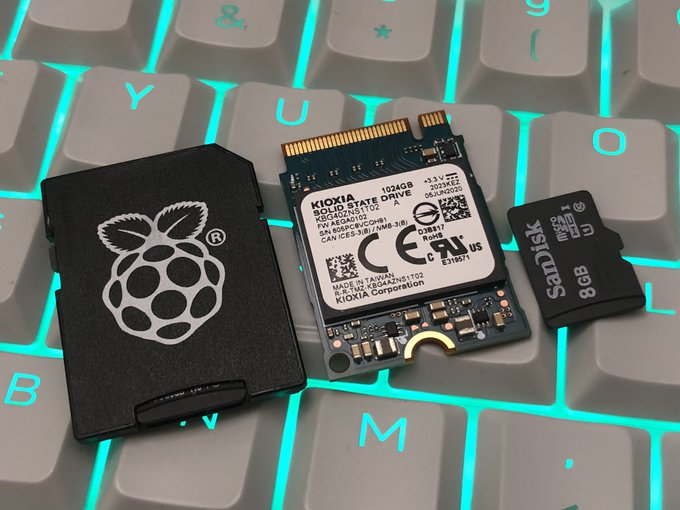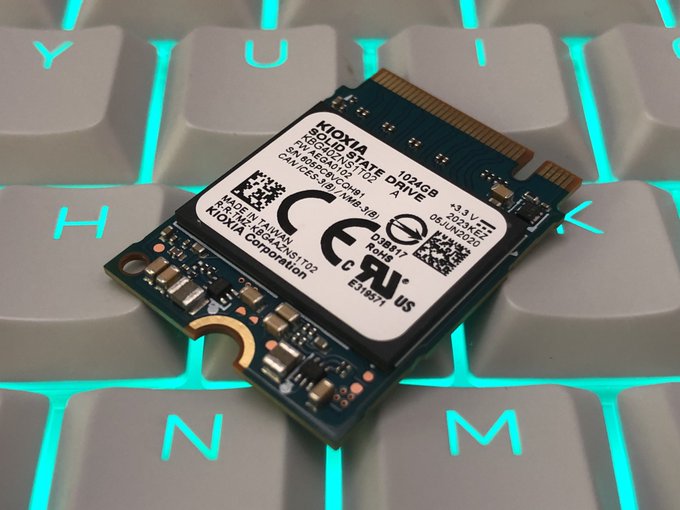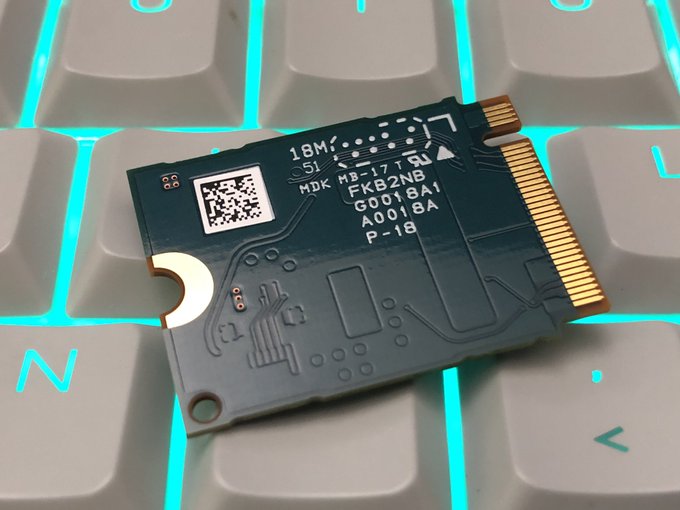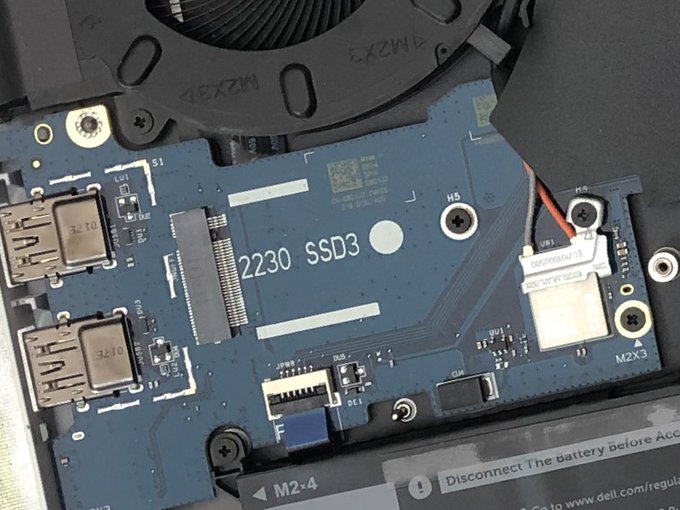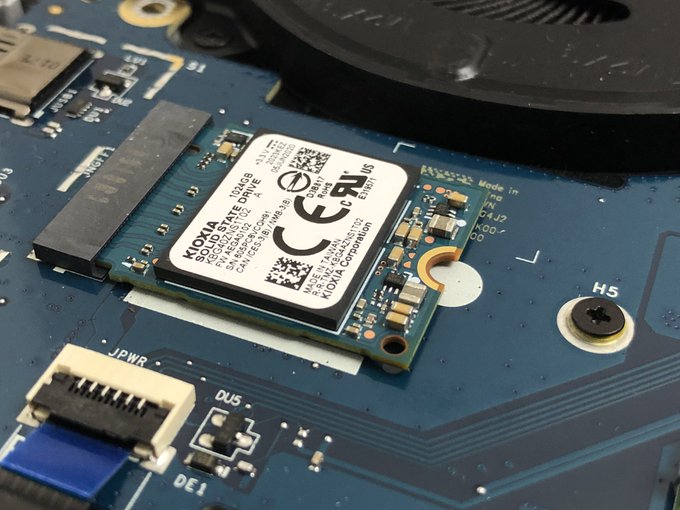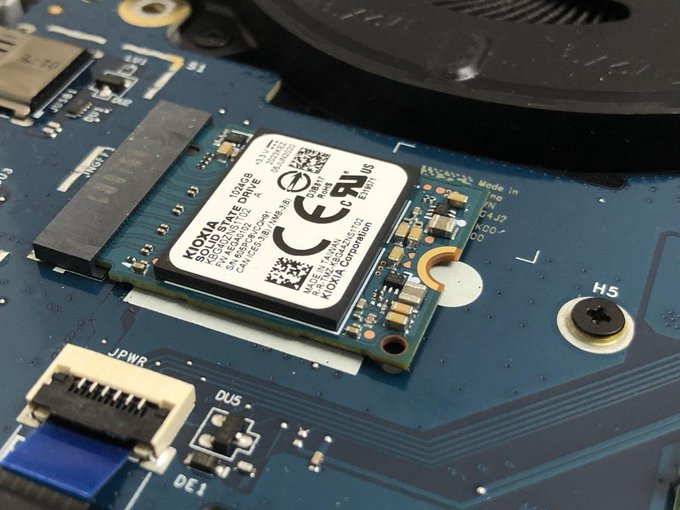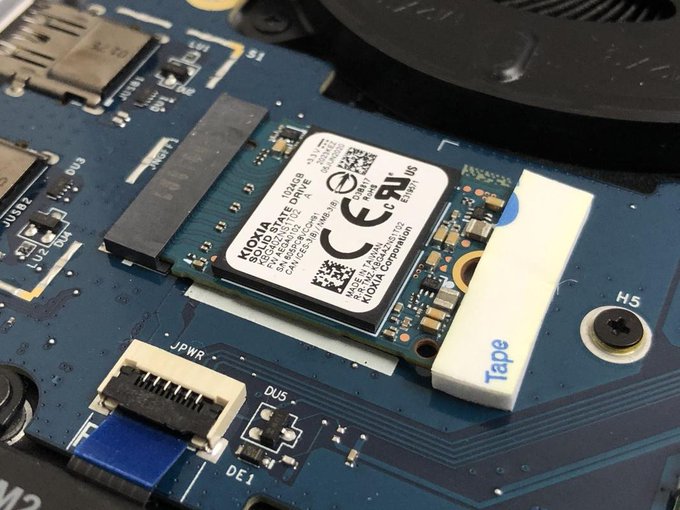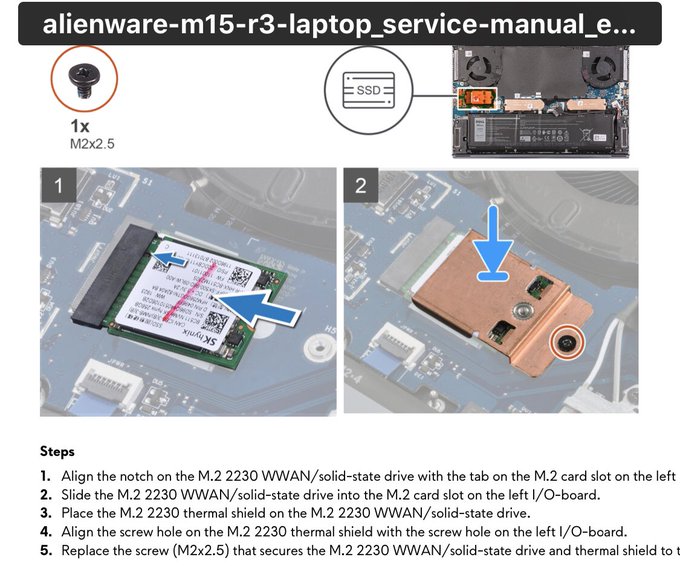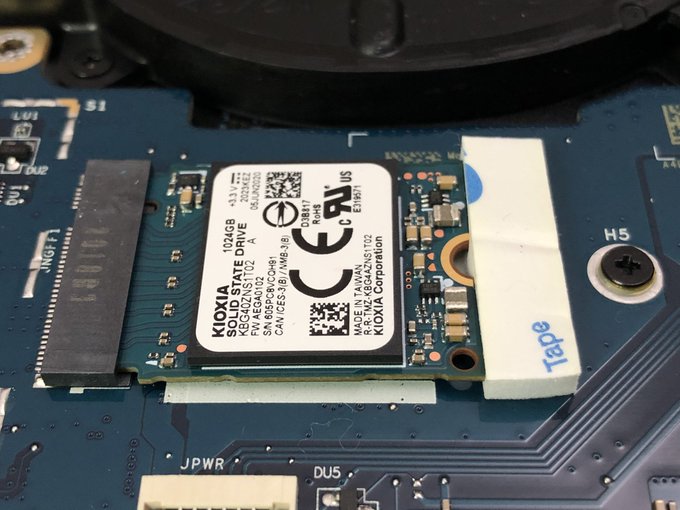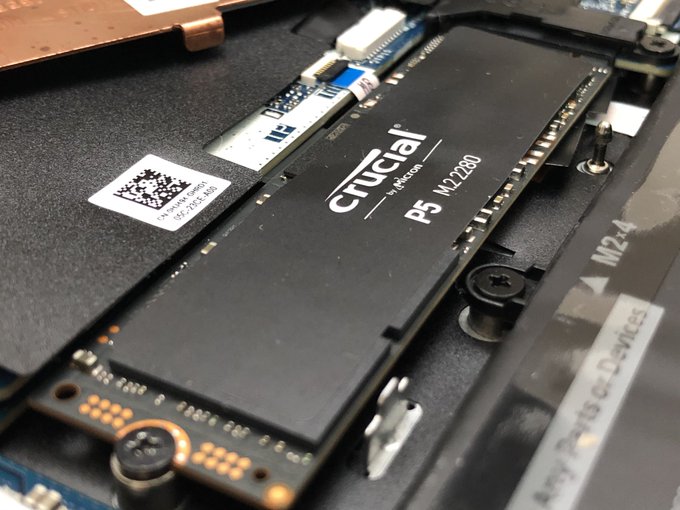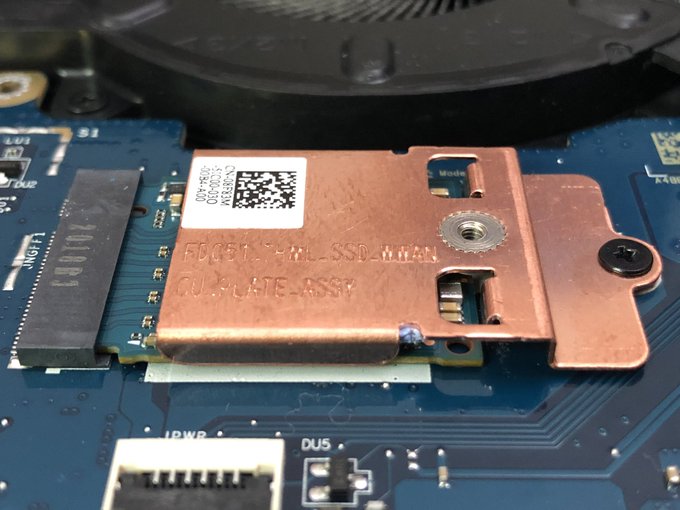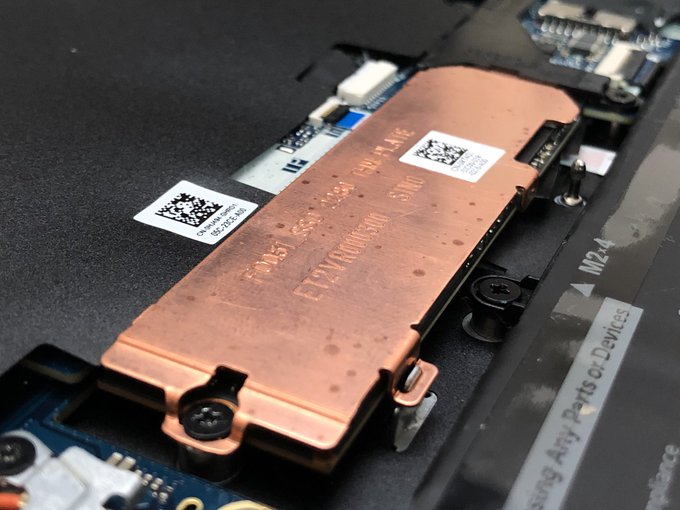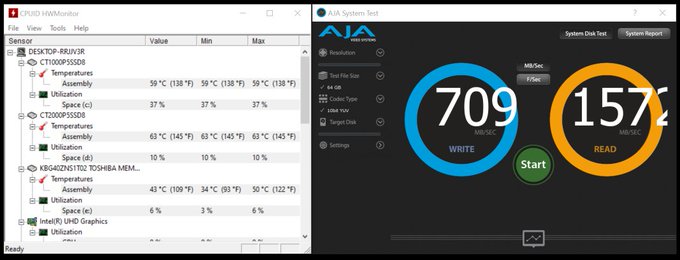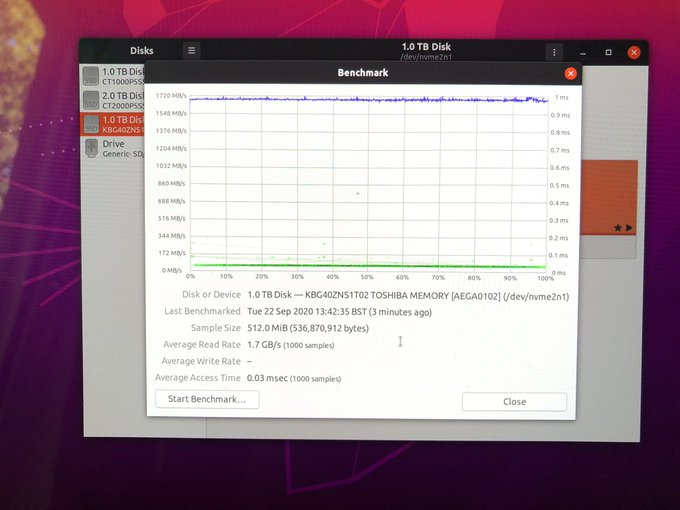Alienware M15 R3 SSD Upgrade – 2230 Bracket Kioxia Edition
The M15 R3 has, surprisingly, a 2230 SSD slot generally reserved for data storage. It’s a welcome addition to Alienware’s M15 R2 successor that offers the opportunity to install a bonus extra disk for dual booting Linux or archiving media files, downloads and other less pressing data.
Finding a 2230 SSD, however, proved to be somewhat difficult. Availability is so sketchy that Surface Laptop owners were pulling the Kioxia SSD out of a CalDigit Tuff Nano in order to upgrade their machines. With the Surface Laptop Go also now presumably sporting a 2230 format SSD the demand for these tiny disk upgrades is only going to get bigger. I had to reach out to Kioxia for a KBG40ZNS1T02. This tiny 30mm SSD offers on-paper read and write speeds of 2,300 MB/s and 1,800 MB/s respectively and the astute reader will notice the “1T” in the drive name does, indeed, correspond to 1024GB of capacity.
The SSD
In a world of 1TB microSD cards I really shouldn’t be shocked by the size of Kioxia’s tiny SSD… or 2230 format SSDs in general- but this thing is TIIINY. It’s really no small wonder that Alienware decided to bung this extra slot into the R3. They had the space to spare and the option of a separate data disk alongside a boot RAID0 configuration is pretty enticing.
Here it is compared to full sized SD and microSD cards. pic.twitter.com/Rb3D443DOs
— Phil Howard (@Gadgetoid) September 4, 2020
On the top side of the SSD is the memory itself, taking up a majority of the space, with a scattering of passives and ICs- presumably to do with power regulation and conditioning- surrounding it.
Sweet lord almighty this thing is tiiiiinnnnnyyyyy! pic.twitter.com/ZI1O61fEil
— Phil Howard (@Gadgetoid) September 4, 2020
The bottom is completely blank, save for silkscreen and the distinct outline of copper traces and pads underneath the PCB resist. There are some interesting features that might be related to heat disspation. Just as well- SSDs have a habit of getting hot, and there’s nowhere much for the heat to go on this tiny, tiny disk.
Has a little ASCII picture of a spider on the back. Hey little guy! pic.twitter.com/UsF9ekt0rP
— Phil Howard (@Gadgetoid) September 4, 2020
Installing into the Alienware M15 R3
Fuelled by my inability to estimate exactly how long 3cm might be, I quickly ran into a problem installing the Kioxia 2230 into my Alienware laptop. The slot, while labelled 2230 SSD3, is either a 2245 slot or something non-standard.
Apparently so!
Though looking at this photo compared to the size/shape of the actual 2230 SSD does not fill me with confidence.
Nothing a bit of blue-tac can’t fix… pic.twitter.com/bkSJecYREO
— Phil Howard (@Gadgetoid) September 4, 2020
It seems deliberately designed to make it impossible to install a 2230 SSD without an additional bracket- perhaps because it’s necessary for cooling, or maybe another screw post simply couldn’t go where that enticing white dot is placed because there’s something exciting on the other side of the motherboard. I’m not sure.
Suspicion confirmed…. uh @Alienware your m15 r3 2230 slot has a nice white dot exactly where a screw should be…. pic.twitter.com/vC5gWdN4fO
— Phil Howard (@Gadgetoid) September 4, 2020
Stubborn as I am, however, I decided to forge ahead and install the SSD anyway. There’s enough friction on the socket for it to stay put without a screw… although I was hesitant to keep it this way. Nothing a bit of 3M tape couldn’t fit- at least to get things up and running.
Had to employ a little artistic license to secure the tiny Kioxia 2230 SSD into the ostensibly 2230 SSD slot on my @Alienware m15 r3… but… IT’S ALIVE. IT’S ALIVE! pic.twitter.com/vkzLnzwFjO
— Phil Howard (@Gadgetoid) September 4, 2020
Quest For The Bracket
What I actually needed was a specific bracket-and-heatsink doodad which would securely screw onto the SSD and, in turn, secure the SSD down to the mainboard.
Ah! From the @Alienware m15 r3 service manual.
Is it *really* a 2230 slot if it requires an additional part that’s not supplied!?
Also… I wonder if a 2242 SSD would fit. Pretty sure I have a SATA one inside my tiny VAIO. Heck of a chore getting it open though. https://t.co/Fpjfy9lMHs pic.twitter.com/uWmwRVJhVW
— Phil Howard (@Gadgetoid) September 6, 2020
Unfortunately Dellienware still don’t supply the extra sundry brackets and heat spreaders required to fit every unpopulated SSD in a new machine. This frustrates me enormously, since they’re tricky and unreasonably expensive for a regular customer to identify and purchase. The part I needed is the “CN-08F83M.” At time of writing… Google has nothing on this and Dell’s own website doesn’t serve me any better.
Fortunately in this case Dell had my back and supplied me with a bumper pack of all-the-brackets and heat spreaders to get a full complement of SSDs up and running in the Alienware M15 R3. They even included a bracket to fit a 2230 SSD into a 2280 slot which will prove extremely useful for testing this SSD in a less potentially bottlenecked slot.
Powering up the @Alienware m15 r3 with some much needed heat spreaders for the Kioxia 2230 SSD and the secondary Crucial P5. pic.twitter.com/Ytm93tgrtG
— Phil Howard (@Gadgetoid) September 22, 2020
Testing The SSD
Since I was waiting on a bracket/heat spreader from Dell for much of my early tinkering with the Kioxia SSD I had to get a little creative during benchmarking. Like the other SSDs installed in the Alienware the poor Kioxia had trouble with shedding excess heat. It’s clear that performance laptops need some active cooling involved with their SSDs, or SSDs need to start running cooler. I honestly dread to think what happens inside something like a Surface Laptop Go, but I suspect less heat from the CPU/GPU and a less performance workload might not push it quite so far.
To get the best results out of benchmarks I used forced-air cooling- a small battery powered fan that forms the base of a wacky-waving-inflatable-tiny-tubeman.
Aaaaaaaaaaaaaaaaaaaaaaaaaaaaaaahhhhhhhhhhhhhhhhhhhhhhhhhh pic.twitter.com/P8rj22eRyb
— Phil Howard (@Gadgetoid) September 4, 2020
This allowed me to hit Write/Read benchmarks of 709MB/s and 1572MB/s in AJA System test.
And here’s the test with overkill cooling. While the write speed hasn’t improved by all that much, read has gone WAAAAAAAAAAAAAAAAAAAAAAAAAAAAY up because the SSD is no longer roasty toasty during the read phase. pic.twitter.com/B6A53DYqkB
— Phil Howard (@Gadgetoid) September 4, 2020
For an auxiliary disk (or something in a basic laptop) this is pretty good and far, far exceeds the performance you’d see from eMMC. You would, however, be forgiven for thinking it’s not up to snuff for a boot disk in a performance system. And you’d be right. I set up the Alienware m15 R3 with 1TB and 2TB boot/storage drives in the 2280 slots and the 1TB Kioxia SSD as a dual-boot Ubuntu Linux disk. Since my workflows in Linux are less concerned with disk throughput (I’m not loading huge videogames) then this lower performance is not noticable. Additionally I think the failure to hit Kioxia’s posted sequential write/read numbers here might be in no small part due to the 2230 slot being bottlenecked. The Core i9 simply runs out of PCIe lanes since the notebook CPU has only 16 and 8 of those are connected to the discrete GPU. If you’re counting, the remaining 8 are split between three SSDs.
With the SSD and heat spreader installed properly, Ubuntu Linux installed and the system booted into Ubuntu I saw slightly faster read speeds- up to 1.7GB/s from 1.5GB/s. These benchmarks aren’t exactly comparable but the 512MB sample size in the linux disk benchmark gets us closer to Kioxia’s theoretical maximum sequential read speed and performance is very consistent.
Thermal throttle bgone pic.twitter.com/0KxRbGzwnE
— Phil Howard (@Gadgetoid) September 22, 2020
In Conclusion
It’s evident I have more testing to do with Kioxia’s KBG40ZNS1T02 and I’m hoping the latest wave of ultra-compact laptops using this form-factor of SSD will give me some fodder for this. Additionally, re-testing this drive in a 2280 slot without the potential bandwidth limitations that the Alienware M15 R3’s imposes on its third SSD slot could notch benchmarks closer to Kioxia’s stated maximums.
First impressions are good- though- it’s a huge SSD to stick into an auxiliary slot and grants the Alienware M15 R3 a responsive Ubuntu Linux dual boot that doesn’t sacrifice the typical Boot/Games SSD configuration of the primary 2280 slots.
The big stickler? Actually obtaining one of these SSDs as an end-user seems to be a little tricky right now. Stay tuned for more!
